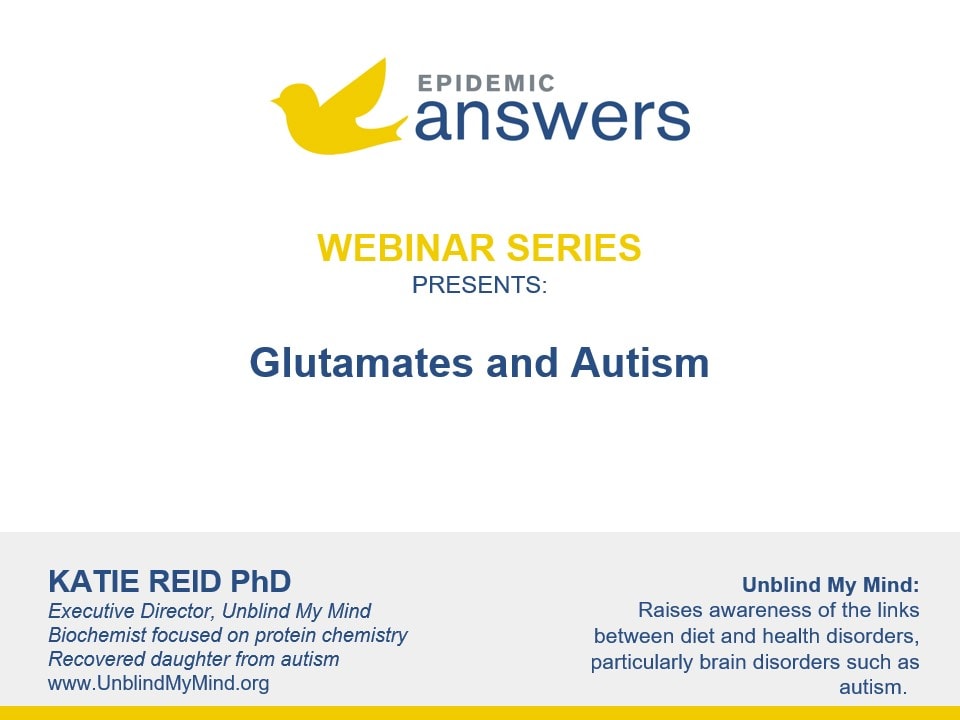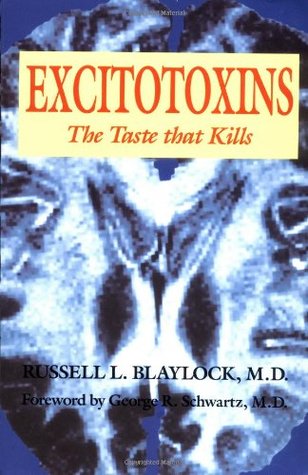We interviewed Andi Stowe of Nourished Blessings about the low-glutamate REID Diet (Reduced Excitatory Inflammatory Diet) developed by Katie Reid PhD of Unblind My Mind. You can watch the replay below. Please note that you will be asked to provide your email address to continue viewing this video at the 30-minute mark.
What Is the Low-Glutamate REID Diet?
Have you heard of the low-glutamate REID diet for children with autism, ADHD and seizures? It’s a diet that’s quickly becoming more widely known and for good reason!
Glutamate is an amino acid that is produced endogenously in the body and also consumed exogenously through foods. It is the most abundant neurotransmitter in our central nervous system, and it is responsible for regulating the receptors of other neurotransmitters.
Free, unbound glutamate in excess in the body causes excitoxicity, in which brain cells become so excited that they die, potentially causing neurological symptoms seen in conditions such as:
- Learning disabilities
- PANDAS and PANS
- Insomnia
- Bedwetting
Processed foods generally contain high levels of free glutamate, and the REID diet excludes them, as well as foods and ingredients that contain high levels of free glutamate including:
- Gluten-containing foods
- Dairy-containing foods
- Monosodium glutamate
- Artificial and natural flavors
- Any food with “umami” such as soy sauce, coconut aminos and Bragg’s aminos
- Bouillon
- Anything containing “glutamate”
- Anything containing “hydrolyzed”
- Anything “autolyzed”
- Any protein “isolate”
- Whey
- Protein powders
For a more comprehensive list, please see our page on the low-glutamate diet.
About Andi Stowe
Andi Stowe is a health and clean eating blogger living in Greenville, SC. She spends her days supporting and educating families to overcome their health struggles by incorporating the cleaner, low-glutamate REID diet. Many of her efforts are centered around the dangers and removal of free glutamate found in many processed foods.
She discovered that her son’s developmental delays and autism symptoms resolved when she removed additives from his diet and worked to balance neurotransmitters. Andi is passionate about bringing awareness to health issues associated with excess glutamate and using food and lifestyle to heal. You can find out more about her and her work at her website nourishedblessings.com

Disclaimer
This information is not a substitute for medical advice, treatment, diagnosis, or consultation with a medical professional. It is intended for general informational purposes only and should not be relied on to make determinations related to treatment of a medical condition. Epidemic Answers has not verified and does not guaranty the accuracy of the information provided.
Still Looking for Answers?
Visit the Epidemic Answers Practitioner Directory to find a practitioner near you.
Join us inside our online membership community for parents, Healing Together, where you’ll find even more healing resources, expert guidance, and a community to support you every step of your child’s healing journey.
Sources & References
Bauer, J., et al. Hyperactivity and impulsivity in adult attention-deficit/hyperactivity disorder is related to glutamatergic dysfunction in the anterior cingulate cortex. World J Biol Psychiatry. 2018 Oct;19(7):538-546.
Blaylock, R.L., et al. Natural plant products and extracts that reduce immunoexcitotoxicity-associated neurodegeneration and promote repair within the central nervous system. Surg Neurol Int. 2012;3:19
Blaylock, R.L. A possible central mechanism in autism spectrum disorders, part 1. Altern Ther Health Med. 2008 Nov-Dec;14(6):46-53.
Blaylock, R.L. A possible central mechanism in autism spectrum disorders, part 2: immunoexcitotoxicity. Altern Ther Health Med. 2009 Jan-Feb;15(1):60-7.
Blaylock, R.L. A possible central mechanism in autism spectrum disorders, part 3: the role of excitotoxin food additives and the synergistic effects of other environmental toxins. Altern Ther Health Med. 2009 Mar-Apr;15(2):56-60.
Blaylock, R.L., et al. Immune-glutamatergic dysfunction as a central mechanism of the autism spectrum disorders. Curr Med Chem. 2009;16(2):157-70.
Bravo, J.A., et al. Ingestion of Lactobacillus strain regulates emotional behavior and central GABA receptor expression in a mouse via the vagus nerve. Proc Natl Acad Sci U S A. 2011 Sep 20;108(38):16050-5.
Breitenkamp, A.F., et al. Voltage-gated Calcium Channels and Autism Spectrum Disorders. Curr Mol Pharmacol. 2015;8(2):123-32.
Brown, M.S., et al. Increased glutamate concentration in the auditory cortex of persons with autism and first-degreer elatives: A(1)H-MR study. Autism Res. 2013;6(1):1–10.
Cartmell, J., et al. Regulation of neurotransmitter release by metabotropic glutamate receptors. J Neurochem. 2000 Sep;75(3):889-907.
Chapman, G. Glutamate and epilepsy. J Nutr. 2000 Apr;130(4S Suppl):1043S-5S.
Choudhury, P.R., et al. Glutamate mediated signaling in the pathophysiology of autism spectrum disorders. Pharmacol Biochem Behav 100(2012)841–849
Cocito, L., et al. GABA and phosphatidylserine in human photosensitivity: a pilot study. Epilepsy Res. 1994 Jan;17(1):49-53.
Coghlan, S., et al. GABA System Dysfunction in Autism and Related Disorders: From Synapse to Symptoms. Neurosci Biobehav Rev. 2012;36(9):2044–2055.
Davalli, D.M., et al. The potential role of glutamate in the current diabetes epidemic. Acta Diabetol. 2012 Jun;49(3):167-83.
DeHavenon, A., et al. The Secret “Spice”: An Undetectable Toxic Cause of Seizure. Neurohospitalist. 2011 Oct; 1(4): 182–186.
Ding, H., et al. Molecular Pathogenesis of Anti-NMDAR Encephalitis. Biomed Res Int. 2015;2015:643409.
D’Souza, C.E., et al. GAD65 antibody-associated autoimmune epilepsy with unique independent bitemporal-onset ictal asystole. Epileptic Disord. 2018 Jun 1;20(3):204-208.
Eimerl, S., et al. Acute glutamate toxicity and its potentiation by serum albumin are determined by the Ca2+ concentration. Neurosci Lett. 130 (1991) 125–127.
El-Ansary, A. GABA and Glutamate Imbalance in Autism and Their Reversal as Novel Hypothesis for Effective Treatment Strategy. Autism and Developmental Disorders. 18, no. 3 (2020): 46-63.
Ende, G., et al. Impulsivity and Aggression in Female BPD and ADHD Patients: Association with ACC Glutamate and GABA Concentrations. Neuropsychopharmacology. 2016 Jan;41(2):410-8.
Essa, M.M., et al. Excitotoxicity in the pathogenesis of autism. Neurotox Res. 2013 May;23(4):393-400.
Feng, Z.M., et al. Monosodium L-Glutamate and Dietary Fat Differently Modify the Composition of the Intestinal Microbiota in Growing Pigs. Obes Facts. 2015;8(2):87-100.
Fernell, E. Further studies of GABA and Glutamate imbalances in autism are important challenges for future research. Acta Paediatr. 2019 Feb;108(2):200-201.
Ford, T.C., et al. Psychosocial deficits across autism and schizotypal spectra are interactively modulated by excitatory and inhibitory neurotransmission. Autism. 2019 Jul 24:1362361319866030.
Gilliam, L.K., et al. Multiplicity of the antibody response to GAD65 in Type I diabetes. Clin Exp Immunol. 2004;138(2):337–341.
Hacohen, Y., et al. N‐methyl‐d‐aspartate (NMDA) receptor antibodies encephalitis mimicking an autistic regression. Dev Med Child Neurol. 2016 Oct;58(10):1092-4.
Haroon, E., et al. Inflammation, Glutamate, and Glia: A Trio of Trouble in Mood Disorders. Neuropsychopharmacology. 2017 Jan;42(1):193-215.
Hassel, B., et al. Brain infection with Staphylococcus aureus leads to high extracellular levels of glutamate, aspartate, γ-aminobutyric acid, and zinc. J Neurosci Res. 2014 Dec;92(12):1792-800.
Herbert, M.R, et al. Autism and EMF? Plausibility of a pathophysiological link–Part I. Pathophysiology 20.3 (2013): 191-209.
Herbert, M.R., et al. Autism and EMF? Plausibility of a pathophysiological link Part II. Pathophysiology 20.3 (2013): 211-234.
Huang, Y., et al. Pyridoxine Supplementation Improves the Activity of Recombinant Glutamate Decarboxylase and the Enzymatic Production of Gama-Aminobutyric Acid. PLoS One. 2016 Jul 20;11(7):e0157466.
Hughes, R., et al. Protein degradation in the large intestine: relevance to colorectal cancer. Curr Issues Intest Microbiol. 2000 Sep;1(2):51-8.
Humphries, P., et al. Direct and indirect cellular effects of aspartame on the brain. Eur J Clin Nutr. 2008 Apr;62(4):451-62.
Kash, S.F., et al. Epilepsy in mice deficient in the 65-kDa isoform of glutamic acid decarboxylase. Proc Natl Acad Sci U S A. 1997;94(25):14060–14065.
Khalifa, D., et al. Serum glutamate was elevated in children aged 3-10 years with autism spectrum disorders when they were compared with controls. Acta Paediatr. 2019 Feb;108(2):295-299.
Luo, P., et al. The role of glutamate receptors in traumatic brain injury: implications for postsynaptic density in pathophysiology. Brain Res Bull. 2011 Jul 15;85(6):313-20.
, J.Z., et al. Prenatal exposure to fipronil disturbs maternal aggressive behavior in rats. Neurotoxicol Teratol. Nov-Dec 2015;52(Pt A):11-6.
Manev, H., et al. Delayed increase of Ca2+ influx elicited by glutamate: role in neuronal death. Mol Pharmacol. 1989 Jul;36(1):106-12.
McNally, L., et al. Inflammation, glutamate, and glia in depression: a literature review. CNS Spectr. 2008 Jun;13(6):501-10.
Naaijen, J., et al. Fronto-Striatal Glutamate in Autism Spectrum Disorder and Obsessive Compulsive Disorder. Neuropsychopharmacology. 2017 Nov;42(12):2456-2465.
Napolini, V., et al. The mitochondrial aspartate/glutamate carrier AGC1 and calcium homeostasis: Physiological links and abnormalities in autism. Mol Neurobiol. 44 (2011) 83–92.
Onaolapo, A.Y., et al. Glutamate and depression: Reflecting a deepening knowledge of the gut and brain effects of a ubiquitous molecule. World J Psychiatry. 2021 Jul 19;11(7):297-315.
Ou, D., et al. Cross-reactive rubella virus and glutamic acid decarboxylase (65 and 67) protein determinants recognised by T cells of patients with Type I diabetes mellitus. Diabetologia. 2000 Jun;43(6):750-62.
Pall, M.L., The Autism Epidemic Is Caused by EMFs, Acting via Calcium Channels and Chemicals Acting via NMDA-Rs: Downstream Effects Cause Autism (conference presentation). 2015.
Pall, M.L., Electromagnetic fields act via activation of voltage‐gated calcium channels to produce beneficial or adverse effects. Journal of Cellular and Molecular Medicine 17.8 (2013): 958-965.
Palmieri, L., et al. Altered calcium homeostasis in autism-spectrum disorders: evidence from biochemical and genetic studies of the mitochondrial aspartate/glutamate carrier AGC. Mol Psychiatry. 2010 Jan;15(1):38-52.
Pelsser, L.M., et al. Effects of a restricted elimination diet on the behaviour of children with attention-deficit hyperactivity disorder (INCA study): a randomised controlled trial. Lancet. 2011 Feb 5;377(9764):494-503.
Pitt, D., et al. Glutamate excitotoxicity in a model of multiple sclerosis. Nat Med. 2000 Jan;6(1):67-70.
Qi, J., et al. Enhanced susceptibility to stress and seizures in GAD65 deficient mice. PLoS One. 2018 Jan 29;13(1):e0191794.
Rojas, D.C. The role of glutamate and its receptors in autism and the use of glutamate receptor antagonists in treatment. J Neural Transm (Vienna). 2014;121(8):891–905.
Rout, U.K., et al. Presence of GAD65 autoantibodies in the serum of children with autism or ADHD. Eur Child Adolesc Psychiatry. 2012 Mar;21(3):141-7.
Rowley, N.M., et al. Glutamate and GABA synthesis, release, transport and metabolism as targets for seizure control. Neurochem Int. 2012 Sep;61(4):546-58.
Sai, Y., et al. Clinical diagnosis and treatment of pediatric anti-N-methyl-D-aspartate receptor encephalitis: A single center retrospective study. Exp Ther Med. 2018 Aug;16(2):1442-1448.
Samuels, A. The toxicity/safety of processed free glutamic acid (MSG): a study in suppression of information. Account Res. 1999;6(4):259-310.
Schauwecker, P.A. The effects of glycemic control on seizures and seizure-induced excitotoxic cell death. BMC Neurosci. 2012 Aug 6;13:94.
Silvestrin, R.B., et al. Animal model of autism induced by prenatal exposure to valproate: altered glutamate metabolism in the hippocampus. BrainRes. 1495 (2013) 52–60.
Takano, T., et al. Glutamate release promotes growth of malignant gliomas. Nat Med. 2001 Sep;7(9):1010-5.
Tang, J., et al. Exposure to 900 MHz electromagnetic fields activates the mkp-1/ERK pathway and causes blood-brain barrier damage and cognitive impairment in rats. Brain Res. 2015 Mar 19;1601:92-101.
Terpstra, M., et al. Changes in human brain glutamate concentration during hypoglycemia: insights into cerebral adaptations in hypoglycemia-associated autonomic failure in type 1 diabetes. J Cereb Blood Flow Metab. 2014;34(5):876–882.
Tzang, R.F., et al. Autism Associated With Anti-NMDAR Encephalitis: Glutamate-Related Therapy. Front Psychiatry. 2019 Jun 21;10:440.
Walls, A.B., et al. GAD65 is essential for synthesis of GABA destined for tonic inhibition regulating epileptiform activity. J Neurochem. 2010 Dec;115(6):1398-408.
Wang, Hsiuying. Anti-NMDA Receptor Encephalitis. Int J Mol Sci. 2017 Jan 18;18(1). pii: E193.
Watkins, J.C., et al. The glutamate story. Br J Pharmacol. 2006 Jan; 147(Suppl 1): S100–S108.
Yang, Y., et al. Role of metabotropic glutamate receptor 7 in autism spectrum disorders: A pilot study. Life Sci. 92 (2013) 149–153.
Zhang, Z., et al. Blood Glutamate Levels in Autism Spectrum Disorder: A Systematic Review and Meta-Analysis. PLoS One. 2016 Jul 8;11(7):e0158688.
Resources
Adams, Mike. The Truth About Aspartame, MSG and Excitoxins. Truth Publishing, Inc., 2010.
Blaylock MD, Russell. Excitoxins: The Taste That Kills. Health Press, 1996.
Lambert, Beth, et al. Brain Under Attack: A Resource for Parents and Caregivers of Children with PANS, PANDAS and Autoimmune Encephalitis. Answers Publications, 2018.
Ross, Julia. The Mood Cure: The 4-Step Program to Take Charge of Your Emotions–Today. Penguin Life, 2003.
Scott, Trudy. The Antianxiety Food Solution: How the Foods You Eat Can Help You Calm Your Anxious Mind, Improve Your Mood and End Cravings. New Harbinger Publications, 2011.
Websites
Amy Yasko’s list of foods with high free glutamates
Amy Yasko’s list of neuroprovokers
How to Increase GABA and Balance Glutamate: Article by Amy Yasko PhD, ND biochemist
Katie Reid’s pantry list of recommended foods.
MSG: Deadly Menace in Your Food: Article by Russell Blaylock MD, neurosurgeon
Natural plant products and extracts that reduce immunoexcitotoxicity-associated neurodegeneration and promote repair within the central nervous system: Peer-reviewed article by Russell Blaylock MD, neurosurgeon
Unblind My Mind: Dr. Reid’s website gives extensive explanation about the science, a TED talk by Dr. Reid and video tutorials to help parent’s discern appropriate foods in a local supermarket
Videos
The Autism Epidemic Is Caused by EMFs, Acting via Calcium Channels and Chemicals Acting via NMDA-Rs
Excitotoxins, Neurotoxins & Human Neurological Disease Lecture by Russell Blaylock MD
Glutamate, Excitoxicity and Autism
Unblind My Mind: What Are We Eating? Dr. Katherine Reid at TEDxYouth@GrassValley



